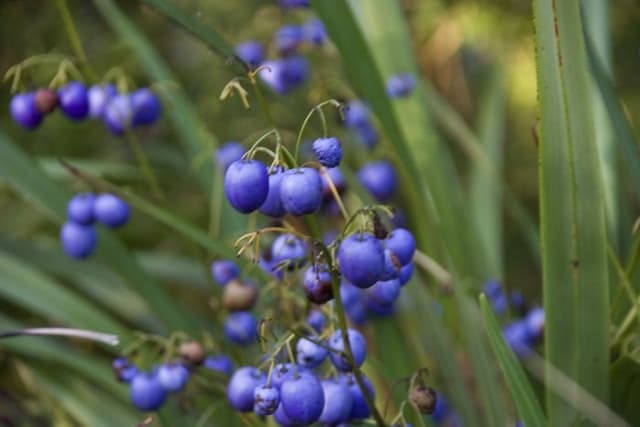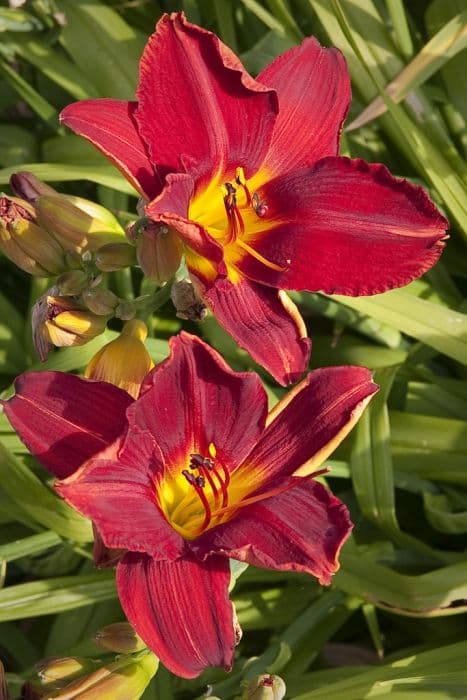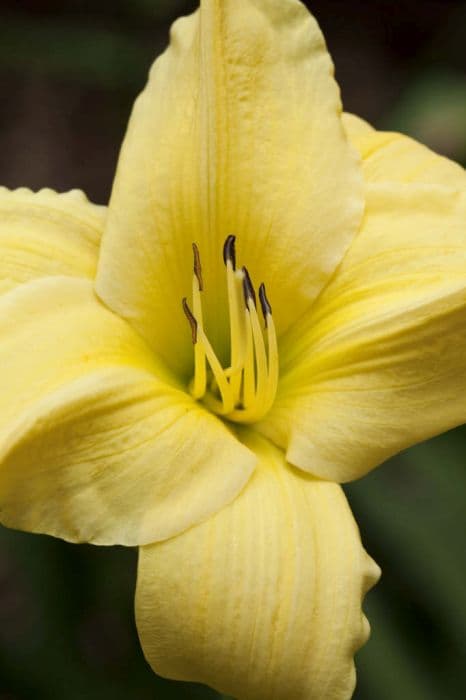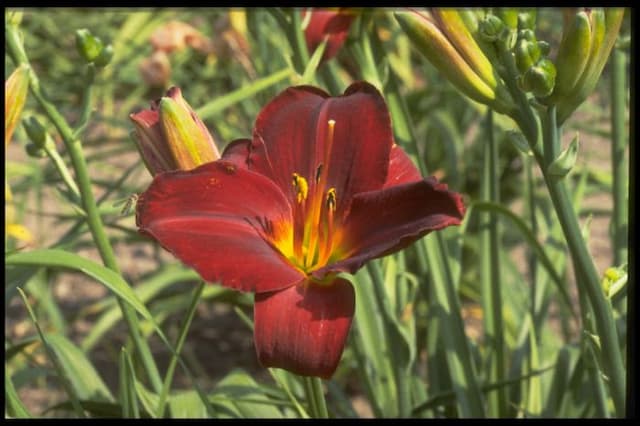Daylily Hemerocallis 'Stoke Poges'

ABOUT
The Hemerocallis 'Stoke Poges' is commonly known as the Daylily. This particular variety showcases a stunning array of blooms that are usually large and showy, making them a focal point in any garden setting. The flowers display a distinctive color, often a blend of soft shades that may include peach, pink, or creamy hues, imparting an impression of a gentle pastel palette. Each blossom typically features a trumpet-like shape with slightly ruffled edges that add to its charm and allure. The petals might also exhibit a subtle gradient or eye-catching contrast along their throats, which is the central part of each flower where it attaches to the stalk. In addition to its charismatic flowers, the Daylily has long, blade-like leaves that grow in dense clumps. These leaves have a rich green color that forms an elegant backdrop to the colorful blooms. The foliage is arching and somewhat grassy in appearance, contributing to the plant's overall texture in the landscape. Daylilies are known for the remarkable fact that each bloom lasts for just one day; however, they produce numerous flower buds on each stem, ensuring a succession of flowers over a period of time during their blooming season. The visual impact of the Hemerocallis 'Stoke Poges' is further enhanced when planted in groups, creating a sweeping display of color and form that truly highlights the plant's beauty. Moreover, this daylily variety is appreciated for its hardiness and ease of care, which adds to its appeal among garden enthusiasts.
About this plant
 Names
NamesFamily
Hemerocallidaceae
Synonyms
Daylily, Stoke Poges Daylily
Common names
Hemerocallis 'Stoke Poges'.
 Toxicity
ToxicityTo humans
The Hemerocallis 'Stoke Poges', commonly known as the daylily, is generally considered non-toxic to humans. Many parts of daylilies are edible, and they are often consumed in some cultures. However, it is important to note that some people may have allergic reactions or sensitivities to daylilies, which can cause symptoms such as gastrointestinal upset, vomiting, or diarrhea. It is always advisable to be cautious when trying any plant for the first time and to ensure correct identification to avoid consuming toxic look-alikes.
To pets
The daylily is known to be highly toxic to cats. Ingesting any part of the plant can cause severe symptoms in felines such as vomiting, lethargy, kidney failure, or even death. The exact toxic compounds are not well understood, but immediate veterinary care is critical if a cat consumes any part of a daylily. In contrast, daylilies are not considered toxic to dogs, but consuming large amounts might still cause mild stomach upset.
 Characteristics
CharacteristicsLife cycle
Perennials
Foliage type
Deciduous
Color of leaves
Green
Flower color
Mixed
Height
2 feet (60 cm)
Spread
2 feet (60 cm)
Plant type
Herb
Hardiness zones
3
Native area
Asia
Benefits
 General Benefits
General Benefits- Ornamental Value: Adds vibrant color with its striking flowers to gardens and landscapes.
- Low Maintenance: Easy to grow and requires minimal care once established.
- Drought Resistance: Capable of surviving periods of low water availability once matured.
- Attracts Wildlife: Flowers can attract butterflies and other beneficial pollinators, enhancing biodiversity.
- Long Bloom Period: Offers a long flowering season, providing continuous aesthetic appeal.
- Erosion Control: The robust root system helps prevent soil erosion in garden settings.
- Adaptability: Tolera a wide range of soil types and environmental conditions.
- Edible Parts: Certain parts of the plant, such as the flowers, are edible and can be used in culinary dishes.
 Medical Properties
Medical PropertiesThis plant is not used for medical purposes.
 Air-purifying Qualities
Air-purifying QualitiesThis plant is not specifically known for air purifying qualities.
 Other Uses
Other Uses- Hemerocallis 'Stoke Poges' petals can be used as a natural dye for fabrics, imparting a soft yellow to orange hue depending on the mordant used.
- The fleshy roots of daylilies can be used in erosion control, as they help to stabilize soil on slopes and banks.
- Daylilies are sometimes used in companion planting to attract beneficial insects that prey on garden pests.
- The stalks of spent flowers are sturdy and can be repurposed as natural supports for other plants in the garden.
- Daylilies can be planted near septic tanks or drain fields as they can tolerate and help mitigate excess moisture and nutrients.
- The thick foliage of daylilies can serve as a living mulch, suppressing weeds and maintaining soil moisture levels.
- Dried daylily petals can be incorporated into homemade potpourri mixes for a light floral fragrance.
- Flower buds and spent blooms can be added to compost piles to contribute to a balanced compost due to their high water and nutrient content.
- Daylilies can be used in floral arrangements and as a source of delicate flowers for cake decorations in culinary arts.
- Live daylily plants can act as a barometer for soil health, as they will show signs of stress when the soil is too dry, too wet, or lacking in certain nutrients.
Interesting Facts
 Feng Shui
Feng ShuiThe Daylily is not used in Feng Shui practice.
 Zodiac Sign Compitability
Zodiac Sign CompitabilityThe Daylily is not used in astrology practice.
 Plant Symbolism
Plant Symbolism- Daylily (Hemerocallis 'Stoke Poges'): Symbolizes the ephemeral nature of life due to the individual flowers lasting for only a day, reflecting the concept of carpe diem or seize the day. It can also represent motherhood and fertility because of its ability to produce numerous offspring.
 Water
WaterDaylilies, including the Hemerocallis 'Stoke Poges', prefer consistent moisture, especially during the growing season. Water the plants deeply about once a week, providing about 1 to 1.5 inches of water each time, which translates approximately to 0.62 to 0.94 gallons for each plant, depending on their size and the weather conditions. Ensure that the soil is well-draining so that the roots do not sit in water. During periods of extreme heat or drought, additional watering may be necessary. In the dormant season, reduce watering significantly, but do not allow the soil to become completely dry.
 Light
LightDaylilies thrive in full sunlight, so the Hemerocallis 'Stoke Poges' should be placed in a location where it receives at least six hours of direct sunlight daily. They can tolerate light shade, particularly in hotter climates, but too much shade may reduce blooming. The ideal spot would offer morning sunlight and some protection from the intense afternoon sun, especially in regions with very hot summers.
 Temperature
TemperatureThe Hemerocallis 'Stoke Poges' daylily is quite hardy and can tolerate a range of temperatures; however, it grows best in conditions between 60°F and 75°F. It can survive minimum winter temperatures down to -20°F and maximum summer temperatures as long as the plant is well-watered. It's important to mulch the base of the plant to help regulate soil temperature and protect the roots in both extremes of cold and heat.
 Pruning
PruningPruning daylilies, including Hemerocallis 'Stoke Poges', mainly involves removing spent flowers and flower stalks to encourage reblooming and to keep the plant looking tidy. After the first flush of blooms, cut back the flowering stems to the base. In late fall or early spring, remove any dead or damaged foliage. Pruning can be done whenever necessary during the growing season to maintain the appearance of the plant.
 Cleaning
CleaningAs needed
 Soil
SoilDaylilies thrive in slightly acidic to neutral soil with pH ranging from 6.0 to 7.0. A well-drained soil mix composed of loam, compost, and perlite or sand is ideal, providing both nutrition and proper drainage to prevent water-logging. Regular amendments with organic matter can be beneficial to maintain soil health.
 Repotting
RepottingDaylilies, including 'Stoke Poges', are generally not repotted as they are perennial plants grown outdoors. Rather, they may be divided every 3 to 5 years to maintain vigor and prevent overcrowding.
 Humidity & Misting
Humidity & MistingDaylilies prefer moderately humid conditions but are quite adaptable to various humidity levels. They can thrive in average garden conditions without requiring any special humidity adjustments.
 Suitable locations
Suitable locationsIndoor
Grow in bright light, ensure pot has drainage, water moderately.
Outdoor
Plant in full sun to partial shade, well-drained soil, water as needed.
Hardiness zone
3-9 USDA
 Life cycle
Life cycleThe daylily 'Stoke Poges' starts its life cycle when a seed germinates in spring after breaking dormancy; however, daylilies are more commonly propagated by dividing the roots of mature plants. After germination or division, the plant develops a rosette of strap-like leaves and establishes a strong root system. During the growing season, it produces tall scapes which bear flowers that typically bloom for only one day each, hence the common name daylily. After the flowering phase, which lasts through the summer with each flower at its peak for a single day, the plant sets seed or spends energy expanding its root system if not deadheaded. In autumn, foliage dies back and the plant enters a period of dormancy, allowing it to survive through winter. With the return of warmer temperatures in the following spring, the daylily resumes growth, completing its annual life cycle.
 Propogation
PropogationPropogation time
Early spring
Propogation: The daylily, known botanically as Hemerocallis 'Stoke Poges', is most commonly propagated by division. This method is best performed in early spring or after the flowering season in late summer to early fall. To propagate by division, dig up the entire plant with a shovel, ensuring to maintain a generous amount of soil around the roots. Gently separate the clumps into smaller sections, each with several shoots and a portion of the root system. Replant the divisions immediately, setting them at the same soil depth they were previously growing and watering them well. Division not only helps to propagate new plants but also invigorates existing clumps that may have become too dense over time, encouraging more vigorous growth and blooming.









